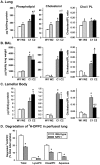Pulmonary abnormalities in animal models due to Niemann-Pick type C1 (NPC1) or C2 (NPC2) disease
- PMID: 23843985
- PMCID: PMC3699545
- DOI: 10.1371/journal.pone.0067084
Pulmonary abnormalities in animal models due to Niemann-Pick type C1 (NPC1) or C2 (NPC2) disease
Abstract
Niemann-Pick C (NPC) disease is due to loss of NPC1 or NPC2 protein function that is required for unesterified cholesterol transport from the endosomal/lysosomal compartment. Though lung involvement is a recognized characteristic of Niemann-Pick type C disease, the pathological features are not well understood. We investigated components of the surfactant system in both NPC1 mutant mice and felines and in NPC2 mutant mice near the end of their expected life span. Histological analysis of the NPC mutant mice demonstrated thickened septae and foamy macrophages/leukocytes. At the level of electron microscopy, NPC1-mutant type II cells had uncharacteristically larger lamellar bodies (LB, mean area 2-fold larger), while NPC2-mutant cells had predominantly smaller lamellar bodies (mean area 50% of normal) than wild type. Bronchoalveolar lavage from NPC1 and NPC2 mutant mice had an approx. 4-fold and 2.5-fold enrichment in phospholipid, respectively, and an approx. 9-fold and 35-fold enrichment in cholesterol, consistent with alveolar lipidosis. Phospholipid and cholesterol also were elevated in type II cell LBs and lung tissue while phospholipid degradation was reduced. Enrichment of surfactant protein-A in the lung and surfactant of the mutant mice was found. Immunocytochemical results showed that cholesterol accumulated in the LBs of the type II cells isolated from the affected mice. Alveolar macrophages from the NPC1 and NPC2 mutant mice were enlarged compared to those from wild type mice and were enriched in phospholipid and cholesterol. Pulmonary features of NPC1 mutant felines reflected the disease described in NPC1 mutant mice. Thus, with the exception of lamellar body size, the lung phenotype seen in the NPC1 and NPC2 mutant mice were similar. The lack of NPC1 and NPC2 proteins resulted in a disruption of the type II cell surfactant system contributing to pulmonary abnormalities.
Conflict of interest statement
Figures










Similar articles
-
Ontogenic changes in lung cholesterol metabolism, lipid content, and histology in mice with Niemann-Pick type C disease.Biochim Biophys Acta. 2014 Jan;1841(1):54-61. doi: 10.1016/j.bbalip.2013.09.010. Epub 2013 Sep 26. Biochim Biophys Acta. 2014. PMID: 24076310 Free PMC article.
-
Molecular dynamics study with mutation shows that N-terminal domain structural re-orientation in Niemann-Pick type C1 is required for proper alignment of cholesterol transport.J Neurochem. 2021 Mar;156(6):967-978. doi: 10.1111/jnc.15150. Epub 2020 Sep 16. J Neurochem. 2021. PMID: 32880929 Free PMC article.
-
Niemann-Pick C1 functions independently of Niemann-Pick C2 in the initial stage of retrograde transport of membrane-impermeable lysosomal cargo.J Biol Chem. 2010 Feb 12;285(7):4983-94. doi: 10.1074/jbc.M109.037622. Epub 2009 Dec 10. J Biol Chem. 2010. PMID: 20007703 Free PMC article.
-
Clinical and Molecular Features of Early Infantile Niemann Pick Type C Disease.Int J Mol Sci. 2020 Jul 17;21(14):5059. doi: 10.3390/ijms21145059. Int J Mol Sci. 2020. PMID: 32709131 Free PMC article. Review.
-
Pre-mRNA splicing defects and RNA binding protein involvement in Niemann Pick type C disease.J Biotechnol. 2020 Jul 20;318:20-30. doi: 10.1016/j.jbiotec.2020.03.012. Epub 2020 May 6. J Biotechnol. 2020. PMID: 32387451 Review.
Cited by
-
Correlation of age of onset and clinical severity in Niemann-Pick disease type C1 with lysosomal abnormalities and gene expression.Sci Rep. 2022 Feb 9;12(1):2162. doi: 10.1038/s41598-022-06112-y. Sci Rep. 2022. PMID: 35140266 Free PMC article.
-
The Genetic Basis, Lung Involvement, and Therapeutic Options in Niemann-Pick Disease: A Comprehensive Review.Biomolecules. 2024 Feb 11;14(2):211. doi: 10.3390/biom14020211. Biomolecules. 2024. PMID: 38397448 Free PMC article. Review.
-
NPC1 Deficiency in Mice is Associated with Fetal Growth Restriction, Neonatal Lethality and Abnormal Lung Pathology.J Clin Med. 2019 Dec 19;9(1):12. doi: 10.3390/jcm9010012. J Clin Med. 2019. PMID: 31861571 Free PMC article.
-
Novel Mutation in the Feline NPC2 Gene in Cats with Niemann-Pick Disease.Animals (Basel). 2023 May 24;13(11):1744. doi: 10.3390/ani13111744. Animals (Basel). 2023. PMID: 37458497 Free PMC article.
-
Extensive macrophage accumulation in young and old Niemann-Pick C1 model mice involves the alternative, M2, activation pathway and inhibition of macrophage apoptosis.Gene. 2016 Mar 10;578(2):242-50. doi: 10.1016/j.gene.2015.12.033. Epub 2015 Dec 18. Gene. 2016. PMID: 26707209 Free PMC article.
References
-
- Griese M, Brasch F, Aldana VR, Cabrera MM, Goelnitz U, et al. (2010) Respiratory disease in Niemann-Pick type C2 is caused by pulmonary alveolar proteinosis. Clin Genet 77: 119–130. - PubMed
-
- Meiner V, Shpitzen S, Mandel H, Klar A, Ben-Neriah Z, et al. (2001) Clinical-biochemical correlation in molecularly characterized patients with Niemann-Pick type C. Genetics in medicine : official journal of the American College of Medical Genetics. 3: 343–348. - PubMed
Publication types
MeSH terms
Substances
Grants and funding
LinkOut - more resources
Full Text Sources
Other Literature Sources
Molecular Biology Databases
Miscellaneous

